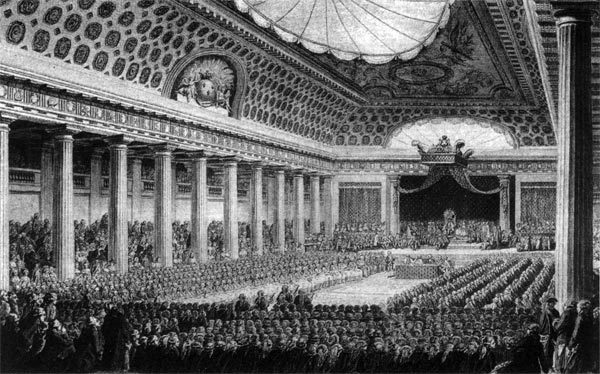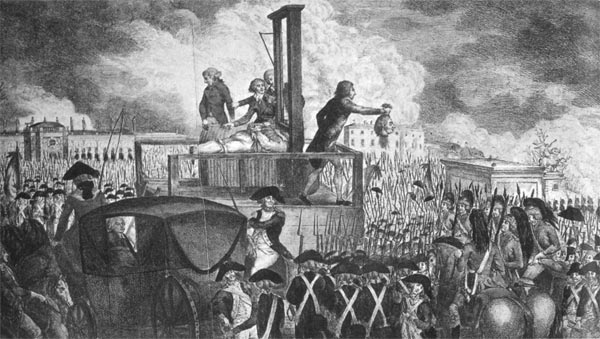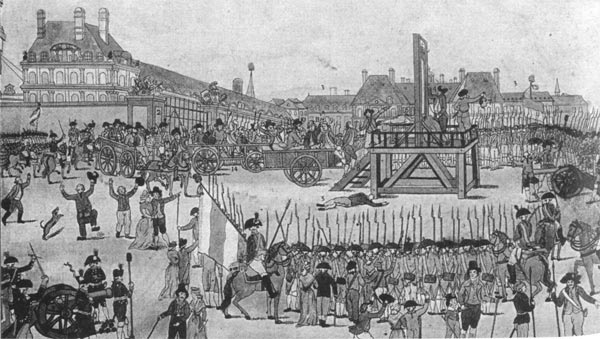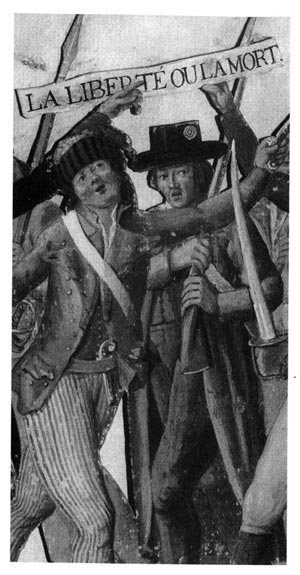Danton - Timeline of the French Revolution
Timeline of the French Revolution

Solemnel opening of the Estates General , May 5, 1789
Timeline of the French Revolution
114
Timeline of the French Revolution
II
Timeline of the French Revolution
Events preceding but pertinent to the French Revolution
- The Enlightenment, which led to many European writers criticising the Monarchy and espousing democratic, liberalist, nationalist and socialist ideas.
1740
- The War of Austrian Succession caused the French nmonarchy to fall heavily into debt.
1756
- Start of the Seven Years' War, which compounded the debt situation.
1775
- Start of the American War of Independence (1775-1783).
1778
- France declares war against Great Britain in support of the American colonies. The subsequent war worsens the debt situation further.
Timeline of the French Revolution
115
Timeline of the French Revolution
1783
- Laki eruption in Iceland and colder climate of the Little Ice Age combined with France's failure to adopt the potato as a staple crop contributes to widespread famine and malnutrition.
- Treaty of Paris ends the war. The success of the American colonists against a European power increases the ambitions of those wishing for reform in France.
Financial crisis and Assembly of Notables
1786
- August 20: Finance minister Calonne informs the King that the royal finances are insolvent.
- December 29: The Assembly of Notables is convoked.
1787
- February 22: First Assembly of Notables meets against a background of state financial instability and general resistance by the nobility to the imposition of taxes and fiscal reforms.
- May 25: The first Assembly of Notables is dissolved.
- July 2: Parlement of Paris overwhelmingly rejects the royal legislation.
- August 6: Legislation passed at a lit de justice. Subsequently the parlement declares the registration was illegal.
1788
- May 8: Judicial reforms partly abolishing the power of parlements to review legislation are forced through the parlements by Lamoignon.
- June: Outcry over the enforced reforms ensues, and courts across France refuse to sit.
- July 5: Brienne begins to consider calling an Estates-General.
Timeline of the French Revolution
116
Timeline of the French Revolution
- August 8: Informed that the royal treasury is empty, Brienne sets May 1, 1789 as the date for the Estates-General to try to restore confidence with creditors.
- August 16: Repayments on government loans stop, and the French government effectively declares bankruptcy.
- November 6: Necker convenes a second Assembly of Notables to discuss the Estates-General.
1789
- April 27: The Reveillon Riots in Paris, due to low wages and food shortages, led to about 25 deaths by troops.
- May 5: The Estates-General is convoked for the first time since 1614.
Estates-General and Constituent Assembly
- May 5: Meeting of the Estates-General - voting to be by Estate, not by head.
- May 28: The Third Estate (Tiers Etat) begins to meet on its own, calling themselves "communes" (commons).
- June 13: Some priests from the First Estate choose to join the Third Estate.
- June 17: The Third Estate (commons) declares itself to be the National Assembly.
- June 20: Third Estate/National Assembly are locked out of meeting houses; the Third Estate decides upon a declarative vow, (The Tennis Court Oath), not to dissolve until the constitution has been established.
- June 27: Louis recognises the validity of the National Assembly, and orders the First and Second Estates to join the Third.
- July 9: National Assembly reconstitutes itself as National Constituent Assembly.
- July 11: Necker dismissed by Louis; populace sack the monasteries, ransack aristocrats' homes in search of food and weapons.
Timeline of the French Revolution
117
Timeline of the French Revolution
- July 13: National Guard formed in Paris, of middle class men.
- July 14: Storming of the Bastille; de Launay, (the governor) is massacred.
- July 16: Necker recalled, troops pulled out of Paris.
- July 17: The beginning of the Great Fear, the peasantry revolt against feudalism and a number of urban disturbances and revolts. Many aristocrats flee Paris to become émigrés. Louis XVI accepts the tricolor cockade.
- August 4: Surrender of feudal rights: The August Decrees.
- August 26: The Assembly adopts The Declaration of the Rights of Man and of the Citizen.
- September 11: The National Assembly grants suspensive veto to Louis XVI; Louis fails to ratify the August acts of the National Assembly.
- October 5-6: Outbreak of the Paris mob; Liberal monarchical constitution; Women's March on Versailles.
- October 6: Louis XVI agrees to ratify the August Decrees, Palace of Versailles stormed. Louis and the National Assembly move to Paris.
1790
- January: Former Provinces of France replaced by new administrative Departments.
- February 13: Suppression of monastic vows and religious orders.
- May: 19 Nobility abolished by the National Assembly.
- July 12:The Civil Constitution of the Clergy. Priests to take an oath of loyalty to the state, splitting the clergy between juring (oath-taking) and non-juring priests.
- July: Growing power of the clubs (including: Cordeliers, Jacobin Club).
Timeline of the French Revolution
118
Timeline of the French Revolution
- July: Reorganization of Paris.
- August 16: The parlements are abolished.
- September: Fall of Necker.
1791
- March 10: The Pope condemns the Civil Constitution of the Clergy.
- June 20-25: Royal family's flight to Varennes.
- June 25: Louis XVI forced to return to Paris.
- July 15: National Assembly declares the King to be inviolable and he is reinstated.
- September 13-14: Louis XVI formally accepts the Constitution.
- September 30: Dissolution of the National Constituent Assembly.
Legislative Assembly
- October 1: Legislative Assembly meets — many young, inexperienced, radical deputies.
1792
- January – March: Food riots in Paris.
- April 20: France declares war against Austria.
- April 28: France invades Austrian Netherlands.
- July 5: Legislative Assembly declares that the fatherland is in danger (La Patrie en Danger).
- July 25: Brunswick Manifesto — warns that should the royal family be harmed by the popular movement, an "exemplary and eternally memorable revenge" will follow.
- July 30: Austria and Prussia begin invasion of France.
- August 1: News of the Brunswick Manifesto reaches Paris — interpreted as proof that Louis XVI is collaborating with the foreign Coalition.
- August 9: Revolutionary commune takes possession of the hotel de ville.
Timeline of the French Revolution
119
Timeline of the French Revolution
- August 10-13: Storming of the Tuileries Palace. Swiss Guard massacred. Louis XVI of France is arrested and taken into custody, along with his family. Georges Danton becomes Minister of Justice.
- August 16: Paris commune presents petition to the Legislative Assembly demanding the establishment of a revolutionary tribunal and election of a National Convention.
- August 19: Lafayette flees to Austria. Invasion of France by Coalition troops led by Duke of Brunswick.
- August 22: Royalist riots in Brittany, Vendee.
- September 3: Fall of Verdun to Brunswick's troops.
- September 3-7: The September Massacres of prisoners in the Paris prisons.
- September 19: Dissolution of Legislative Assembly.
National Convention
- September 20: First session of National Convention. French Army stops advance of Coalition troops at Valmy.
- September 21: Abolition of royalty and proclamation of the First French Republic.
- September 22: First day of the French Revolutionary Calendar (calendar introduced in 1793).
- December 3: Louis XVI brought to trial, appears before the National Convention. Robespierre argues that "Louis must die, so that the country may live".
1793
- January 21: Citizen Louis Capet (ex. Louis. XVI) guillotined.
- March 7: Outbreak of rebellion against the Revolution: War in the Vendee.
- March 11: Revolutionary Tribunal established in Paris.
- April 6: Committee of Public Safety established.
- May 30: A revolt breaks out in Lyon.
Timeline of the French Revolution
120
Timeline of the French Revolution
- June 2: Arrest of Girondist deputies to National Convention by Jacobins.
- June 10: Jacobins gain control of the Committee of Public Safety.
- June 24: Ratification of new Constitution by National Convention, but not yet proclaimed.
- July 27: Robespierre elected to Committee of Public Safety.
July 28: Convention proscribes 21 Girondist deputies as enemies of France.
August 23: Levee en masse (conscription) order.
- September 5: Start of Reign of Terror.
- September 9: Establishment of sans-culottes paramilitary forces — revolutionary armies.
- September 17: Law of Suspects passed.
- September 22: A new calendar is introduced, with September 22, 1792, as the start of year I.
- September 29: Convention passes the general maximum decree, fixing the prices of many goods and services.
- October 10: The Constitution of 1793 is put on hold; decree that the government must be "revolutionary until the peace".
- October 16: The former Queen Marie-Antoinette is guillotined.
- October 31: The 21 Girondist deputies guillotined.
- December 4: Law of 14 Frimaire (Lawof Revolutionary Government) passed; power becomes centralised on the Committee of Public Safety.
1794
- March 30: Danton, Desmoulins and their supporters arrested.
- April 5: Danton and Desmoulins guillotined.
- May 7: National Convention, led by Robespierre, passes decree to establish the Cult of the Supreme Being.
Timeline of the French Revolution
121
Timeline of the French Revolution

Execution of the King

Execution of Robespierre
Timeline of the French Revolution
122
Timeline of the French Revolution
- June 8: Festival of the Supreme Being.
- June 26: French forces defeat Austrians at the Battle of Fleurus.
- July 27-28: Night of 9-10 Thermidor — Robespierre arrested, guillotined without trial, along with other members of the Committee of Public Safety. End of the Reign of Terror. Also called The Thermidorian Reaction.
- Latter half of 1794: The White Terror — reaction against remaining Jacobins.
1795
- May 31: Suppression of the Paris Revolutionary Tribunal.
- August 22: 1795 Constitution ratified — bicameral system, executive Directory of five.
- October 26: National Convention dissolved.
The Directory
- November 2: Executive Directory takes on executive power.
1799
- November 9: The Coup d'Etat of 18 Brumaire: end of the Directory
- December 24: Constitution of the Year VIII — leadership of Napoleon established under the Consulate. French Revolution may be considered ended.
Timeline of the French Revolution
123
Timeline of the French Revolution
 La Liberte Oulamort
La Liberte Oulamort
Timeline of the French Revolution
124
Related Books
- Alexander the Great
- Arguments for The Existence of God
- But it is done
- Catherine The Great
- Danton
- Episodes from Raghuvamsham of Kalidasa
- Gods and The World
- Homer and The Iliad - Sri Aurobindo and Ilion
- Indian Institute of Teacher Education
- Joan of Arc
- Lenin
- Leonardo Da Vinci
- Lincoln Idealist and Pragmatist
- Marie Sklodowska Curie
- Mystery and Excellence on The Human Body
- Nachiketas
- Nala and Damayanti
- Napoleon
- Parvati's Tapasya
- Science and Spirituality
- Socrates
- Sri Krishna in Brindavan
- Sri Rama
- Svapnavasavadattam
- Taittiriya Upanishad
- The Aim of Life
- The Crucifixion
- The Good Teacher and The Good Pupil
- The Power of Love
- The Siege of Troy
- Uniting Men - Jean Monnet